The Museum Collections
Introduction
I. History and Art Collection
1. Icons of the 14th – 19th centuries
icons of the 14th – 17th century
2. Jewelry art of the 14th – 20th century
jewelry art of the 14th – 17th century
jewelry art of the 18th – 19th century
the european silver 14th - 19th centuries
3. Small-size sculptures (works of metal, wood, bone)
XI – the beginning of the XX century
Small-size sculptures 11th – 17th century
Small-size sculptures 18th – early 20th century
enamel of Troitza masters 15-8th – early 20th century
5.Embroidery, lace, textiles of the 14th - early 20th century
icon and ornamental embroidery
gold and silver lace
6.Painting of the 18th – 21st centuries
painting of the 18th – 19th centuris
painting of the 20th – 21st centuris
II.Manuscripts and old printed books of the 14th – 17th century
IV.Lithography of the 18th – 19th century
V.Numismatics
VI.Medals of the 18th - early 20th century
VIII.Archeology collection
IX. Russian folk and applied and decorative art of the 17th – 21st c.
1. Artistic wood
folk carved and painted wood
wooden toys
house carving of Sergiev Posad
Khokhloma and Gorodets painting
2. Artistic textiles
embroidery and weaving
printed textiles and lace
Russian shawls
folk costumes
folk garments
printed cotton kerchiefs
|
Painting of the 18th – 19th century(p.1) |
In the Sergiev Posad museum, there is small, but interesting collection of the painting of 18-th - beginning 20-th centuries and Sergiev Posad’s artists of 20 - 21-st centuries. The collection includes fine samples of portrait painting of the 18-th century, portraits of the 19-th century, various on art methods and principles, rare allegories and landscape etudes of 19-th century. The considerable part of works of modern artists is images of the Trinity-St. Sergius Lavra and city, landscapes, still-lifes and portraits.
In the museum are canvases of unknown painters too. The part of works has created by artists, which played insignificant roles in development of Russian painting of 18-th and 19-th centuries. The part of canvases allows speaking about the picturesque studios of the Trinity-St. Sergius monastery, which existed from 18-th century until the beginning of 20-th century. The painting collection of the end of 19-21-th centuries is the logic continuation and completion of works of Ancient Russia and New time fine arts. It gives the splendid possibility to track development of art traditions of Sergiev Posad for all previous century.
The higher achievement of Russian art culture in the 18-th and 19-th centuries became a portrait. In it were embodied searches of a place and value of the person in world around, attention to the human personality, new understanding of ethical, civil and moral value of the man and its inwardness. The portrait of tsarina Praskoviya Fedorovna Saltykova (1664-1723) (Ill. 1 ), wives of tsar Joann Alekseevich, attributed to the known artist of the first third 18-th century Ivan Nikitich Nikitin (c. 1680 – c. 1742). This portrait concerns to works of Peter I’s time.
Different artists, as capital and local, created the Monastery gallery. In the collection of the museum locates the portrait of tsar Joann Alekseevich (Ill. 2), which is a self copy of the big portrait, created in the end of 17-th century. It located in the Romanovsky gallery of Winter Palace. It is possible, that the engraving, created by Philippo Giorgio Mattarnovi, served as the sample for this portrait. The largest Russian artist of 18th century Alexey Petrovich Antropov (1716–1795) has connected with the Troitsk monastery and its figures during many decades of his creative life. During the period between 1744 and 1751, he painted a smart portrait of Empress Elizabeth Petrovna (Ill. 3),for Imperial halls. In 1762, he created coronation portraits of Peter III(Ill. 4) ) and Catherine II for Monastery, and in 1770–1780th years he painted the portrait of Troitsk archimandrite and Moscow metropolitan Platon Levshin.
|
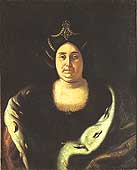
Ill. 1 |
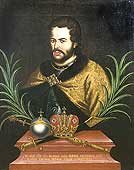
Ill. 2 |
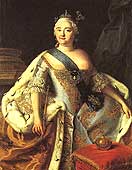
Ill. 3 |
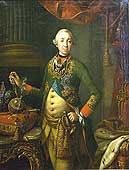
Ill. 4
|
Among portraits of crowned persons in the museum collection most of all are images of Catherine II. This explains especially warm relations, existing between her and metropolitan Platon. He has erected by the Empress in the higher holy order and put by her the teacher of law to the successor. Among these portraits is one excellent on painting, integral and stylistic sustained portrait of young grand duchess Ekaterina Alekseevna (Ill. 5), future empress Catherine II. Later, after crowning separate details have copied: on the head has appeared a crown, instead the red tape - blue, St.Andrey’s, a flower was replacement to a staff. For gallery of the Archimandrite house of the Trinity-St. Sergius Lavra has been created (presumably by artist L.C. Pfandtzelt) and Peter Fedorovich portrait (1728-1762) (Ill. 6), future emperor Peter III.
Smart portrait of grand duke Paul Petrovich in growth, on which the grand duke has represented in an admiral's uniform (Ill. 7), ), is attribute to V.Eriksen and created in 60th years of the 18-th centuries. The portrait has presented to teacher of the successor – metropolitan Platon Levshin and decorated a reception hall of its Vifansky residence. There is one more portrait of grand duke Paul Petrovich (Ill. 8), which presumably has executed by known painter Jean-Louis Voille, dated the end of the 18-th century.
|

Ill. 5 |
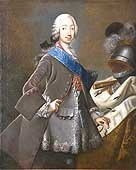
Ill. 6 |
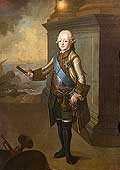
Ill. 7
|
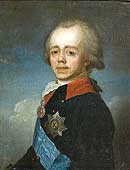
Ill. 8 |
The substantial number of portraits of priors of the Trinity-St. Sergius Lavra and other clerics were in monastic collection. The most part of these portraits has transferred to Russian Church. Some portraits of metropolitan Platon, and archimandrites Gedeon Krinovsky, Laurentius Hotsyatovsky, Augustinus Vinogradsky etc remained in the museum collection. Unknown artists with different degree of skill painted almost all of them. A typical smart portrait from collection of the Trinity-St. Sergius Lavra is the portrait of metropolitan Platon (Ill. 9), represented dressed in expensive clothes and magnificent mitre – the endowment of Elizabeth Petrovna in 1744. On Platon's breast are two panagias, one of which is diamond (Lavra’s), and the second is presented to Platon in 1775 by Catherine II and Potyomkin.
One of the earliest works of Peter Drozhzhin, the apprentice A. P.Antropov, also has connected with Lavra’s collection. Peter Drozhzhin has begun the career, probably, in the Trinity-St. Sergius Lavra, where he studied at the painter P.Kazanovich. The portrait of archimandrite Lavrentius Hotsjatovsky (Ill. 10) has written in 1765, when Drozhzhin was apprentice of Antropov. It is necessary to note that the portrait of the archimandrite of the Trinity-St. Sergius Lavra Gedeon Krinovsky created in Lavra’s workshop between 1770 -1775 (Ill. 11).
The picture "Italian landscape» by F.M.Matveev (Ill. 12), written in Rome on boundary of 18-19th centuries, come forth among the museum collection of the 18-th century, where, basically, there are portraits. Matveev has gone to Italy in 1779, as the pensioner of the Academy of arts, who have received the big gold medal, but not return home. The contemporaries, knowing Matveev in Rome, highly appreciated its creativity and considered its best landscape writer of time.
|
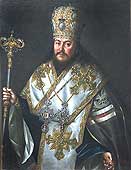
Ill. 9 |
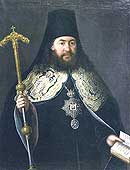
Ill. 10 |
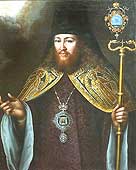
Ill. 11 |
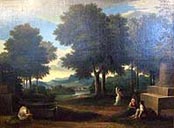
Ill. 12
|
|


